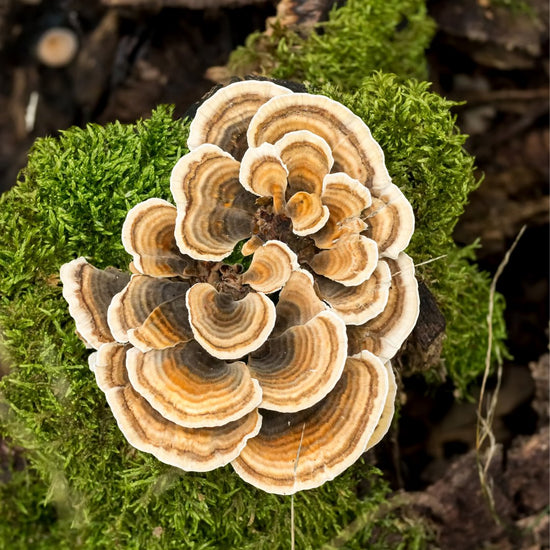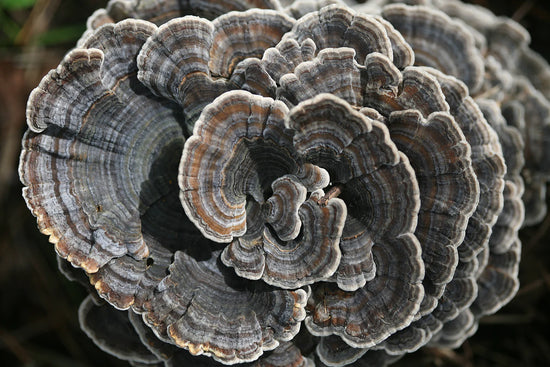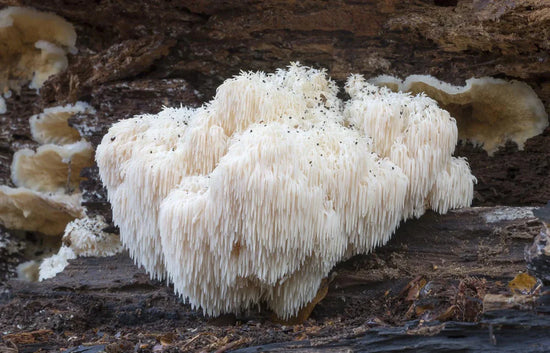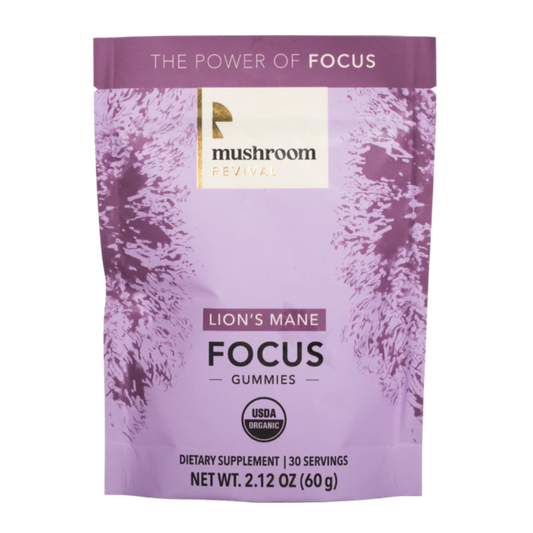SPoOkY mUsHroOms
Encore episode! In honor of spooky season, we bring you a compilation of freaky fungus facts. We talk fungal decay, fungal poisons, fungi that never seem to die, bizarre biochemistry, how fungi are taking over the world, and more. Tune in, shroom in, and get into the spirit of Halloween with our special edition SPoOkY mUsHroOms episode!

Our top favorite freaky fungus facts:
1. Fungi have taken over every kingdom of life.
Plant, animal, human, bacterial, other fungi... you name it, fungi have found a way to infiltrate it. Even tardigrades fall mercy to the chytrids.
2. Fungi are the last to die.
Candida, a ubiquitous and deeply problematic fungus to those with weakened immunity, has outlived all other microbes in a hospital that was treated with industrial sterilizers. You can read more about this here:
https://www.imperial.ac.uk/stories/antifungal-resistance/
3. Zombies are real. Thanks to cordyceps.
This infamous genus of fungi, Cordyceps, has zombified many species of insects. For some stunning images, visit our friend Daniel Winkler's archives: https://mushroaming.com/Cordyceps-articles
Show Notes:
Death Cap: Amanita phalloides: https://en.wikipedia.org/wiki/Amanita_phalloides
Corpse Finder Mushroom Hebeloma vinosophyllum: http://www.dannyhaelewaters.com/wp-content/uploads/2013/10/haelewaters-2013-hebeloma-pioneer-genus-in-forensic-mycology.pdf
Agaricus bisporus vaccine production: https://news.psu.edu/video/224110/2011/06/08/mushroom-used-produce-vaccines
Dead Man’s Fingers: https://www.first-nature.com/fungi/xylaria-polymorpha.php
Bleeding Fungus: https://en.wikipedia.org/wiki/Hydnellum_peckii
Bleeding Octopus Stinkhorn: https://en.wikipedia.org/wiki/Clathrus_archeri
Chytrid parasite on tardigrades: https://cdnsciencepub.com/doi/abs/10.1139/b85-211
Massospora “Flying Salt Shakers of Death”: https://blog.mycology.cornell.edu/2013/02/19/flying-salt-shakers-of-death/
Fungal parasites on nematodes: https://en.wikipedia.org/wiki/Nematophagous_fungus
Serpula lacrymans: https://en.wikipedia.org/wiki/Serpula_lacrymans
Lascaux Cave Fungus
Rose Growers Disease: https://www.cdc.gov/fungal/diseases/sporotrichosis/index.html
Trichophyton infectious fungi: https://en.wikipedia.org/wiki/Trichophyton
Poison Coral Fungus: https://www.ncbi.nlm.nih.gov/pmc/articles/PMC3521283/
Mushrooms fruiting in lungs: https://www.ncbi.nlm.nih.gov/pmc/articles/PMC228320/pdf/331979.pdf
Antifungal Resistance Candida: https://www.imperial.ac.uk/stories/antifungal-resistance/
Mushroom Death Suit: https://www.sciencealert.com/this-mushroom-suit-digests-your-body-after-you-die
Blood Spore: https://harpers.org/archive/2013/07/blood-spore/
TRANSCRIPT
You're listening to the mushroom revival podcast.
Lera 0:03
We are re releasing our Halloween episode from two years ago 2019 and to this day, it was one of my favorite episodes but after going back and re listening to it, I realized we've come such a long way, not only as human beings but as scientists as mycologist as podcasters you name it a lot can happen in two years. Still, what a delightful compiled nation of freaky fungus facts.
Alex 0:33
This was really funny I actually really liked recording this episode because I think it was on a Friday and we just had a really good week and it was right before Halloween which is your favorite holiday and so we're getting in the spirit and we were working our butts off at the farm and we always had to record in my room and this we always did it at my desk but this specific episode we did it on my bed and we were just kind of sprawled out end of the day on Friday we're having a good week and we had a soundboard of all these spooky sounds and we had a great conversation it was it was awesome so is it.
Lera 1:10
Soundboard as in your iPhone six?
Alex 1:12
Yeah, probably whatever it's pretty corny you guys there's a lot of corny sound effects but we hope you like it isn't and we're crowded around one really shitty mic and but we had we had a fun time and we hope you like it. But to jump in. We want to give the review of the week this one is coming from person man 247937. The title is great pod and the review super assisting is this is a great listen and very informative. So thank you person pan. for your review. If you want to be featured on our show, you can do so by leaving a review and we pick one a week that we feature on our show. Other ways you can support us is going to our website mushroom revival calm we have a whole line of functional mushroom liquid extracts to support your health. And if you're listening to this in October 2021 that's all we have right now is liquid mushroom extracts or tinctures. But in the beginning of November 2021, we are releasing organic capsules, we're releasing organic powder, we're releasing organic gummies and then 2022 we have six new products that we're releasing that are really changing the game in the mushroom industry. We're super friggin pumped about it. So go there and support us we have a special coupon code for you guys. pod treat. Keeping in it's funny, we didn't even make that coupon code to have anything to do with Halloween but it fits with the trigger cheer Trick or Treat vibes we got going on. So that is pod treat. We won't even tell you how much you're going to save or how much that discount is for. It's a little surprise waiting for you. little easter egg or you know, Halloween treat. So without further ado,
Lera 3:16
we bring you spooky mushrooms 2.0
Alex 3:49
It's Halloween everyone. We're gonna get spooky. Yeah,
Lera 3:54
we've been compiling a lot of freaky facts for you. So let's dive in.
Alex 4:06
So to start out our list, we are going to talk about death cap. So Amanita Floyd is is one of the few deadly fungi. And it's one of the most poisonous of all mushrooms. And here in the northeast. It's one of the most iconic mushrooms that foragers have to look out for, because it's really really deadly. It is been involved in the majority of human deaths from mushroom poisoning, and possibly including the deaths of Roman Emperor Claudius and at 54. And Holy Roman Emperor Charles the sixth in 1740. At least one person has died each year in North America from death cap ingestion. I will kill you Since cases highlight the issue of this similarity between this death cap mushroom to the edible Paddy straw mushroom, Paddy straw mushroom is really common in East and Southeast Asian countries. And when a lot of these immigrants come over from these countries, they're really familiar with this Paddy straw mushroom, and when they are out foraging in the wild, there's a lot of instances of a mix up between this Paddy straw mushroom, and now the death cap, which we have over here in the North America. So there's a lot of deaths associated with Eastern Southeast Asian immigrants coming over and falling victim to this trap. There's an episode in Oregon where four members of a Korean family required liver transplants from feeding their family, these death got mushrooms that they thought were the yummy Paddy straw mushroom. So they're very nomadic. They're traveling to other species of trees, and they're naturalizing and there's no way to stop them. It kills your your cells and concentrates in your liver and kidneys, and eventually will shut down your organs. So this is a really gnarly way to go out. And I don't recommend it to anyone.
Lera 6:34
Our next mushroom is called the corpse finder mushroom, and it's very appropriately named because of an obvious reason and typically indicates the presence of decaying mammals or other dying humans. Like many mushrooms, the corpse finder is a decomposer and lives on dead organic material. Apparently, a whole cluster of these mushrooms helped find a shallow burial site of a human corpse to solve a crime. So this is a heavy Aloma species and it's has potential in the forensic world, which is pretty cool. It's a very unassuming mushroom, it just looks like an LBM. That's little brown mushroom. It's an interesting case and we don't want to miss enlighten. It's not like it's growing directly from the cadaver, but it's actually feeding off of the excess nitrogen. That is due to the cadavers decomposition. It's been found growing from a lot of birds. And I think that was the first case habe Aloma vinos phylum.
Alex 7:45
So the next mushroom that we're going to talk about is lentinus lebuh ds, and it owns some of the blame for the self defeat during the Civil War. So in the book, mushroom molds and miracles the author reported that many of the train sent to support General Robert E. Lee's troops never made it due to cotton rail, what ties that were degraded due to this land tightness species. Another species that is super notable is are got so it's derived from quadriceps per year. And they're used to induce abortions decrease postpartum bleeding and treat migraines. This was also the fungi that made LSD that was synthesized by Albert Hoffman will get a little more into LSD later on to the podcast. And this or God is pretty incredible. The ergotamine in our gut is metabolized in humans to list lists ergic acid, but for many centuries are got caused acute poisoning. So there's two types of ergotism possibly because of two different strains of collapse seps purpurea. One is gangrenous, where victims lose part of their body parts their extremities, like fingers, toes, ear lobes, and the other one is convulsive ergotism, which is characterized by hallucinations and awful self self destructive behaviors. This was known as St. Anthony's fire in the Middle Ages. And I've also heard this is what happened in the Salem Witch witch trials is that ergotism broke out in Salem, Massachusetts, and a lot of the locals thought it was witchcraft and so they burned a lot of women at the stake, accusing them of witchcraft when it was just ergotism. That was happening. So, a cultural biologist believes that this was the case in Salem. And human sweat was also reported to smell like dead mice are still urine when they're infected with ergotism. Just creepy, add some more creepy factory.
Lera 10:24
The next mushroom we're going to talk about is jack o' lantern mushroom. And we just have to talk about this. It's called jack o' lantern. And for those of you who know why, it's because it's glows underneath it's goes and it's an orange color. It's very appropriately named as well. It is poisonous, so don't eat it. And another fun fact is the enzyme that makes the glow is called Lucifer. Yes. And I wanted to highlight that because it's so similar to the name Lucifer which is evil and creepy. The etymology of Lucifer is interesting, it actually means bright shining light. This the genome and luciferase has been used in labs to make other organisms glow as well. Subjects so far include tobacco, plants, trees, rabbits, sheep, pigs, monkeys, dogs, cats and fish. There's even more that they're working on. So that's, that's so creepy. Yeah, it's it's evil. Maybe not evil, but definitely an interesting application for genetically modifying organisms. It seems like people are just having fun in the lab. like can we make this thing glow? Let's let's try and insert this genomic
Alex 11:47
lesson cert Lucifer into all these things and then make this
Lera 11:51
Exactly, exactly. And then we're going to talk about Agaricus bisporus. And this was just kind of a strange Fun fact that I dug up. But the mycelium of Agaricus bisporus is used in molecular farming and that's farming spelled with a Ph. So there's a new technique that's been developed to replace eggs or whatever media that they were propagating these vaccines in with Agaricus bisporus mycelium. Basically the process is you insert a gene that produces a vaccine into a bacterium that is then inserted into the mycelium and the mushrooms that produce the needed chemical or cultured to produce the strains that carry the chemical. And then you harvest that chemical from the mycelium and people have been doing this because it's extremely efficient. up to 3 million doses of vaccine in 12 weeks can be made out of this molecular farming so that was really interesting. I read this in myco philia Yeah, so a little Did you know your your pizza mushroom is behind the scenes doing some freaky vaccine work in molecular farming
Alex 13:15
does that make you want to eat mushrooms?
Lera 13:18
Now in your hate button mushrooms
Alex 13:20
I do hate I do hate mushroom
Lera 13:22
but like you you'll pick them out of your food or just not eat whatever Yeah,
Alex 13:26
yeah, we actually just ordered some crepes and he refused they didn't want to eat it yeah
Lera 13:33
bad I'm not they're not great but they're not bad
Alex 13:38
they're pretty bad yeah, there's I mean there's so many other mushrooms there's so good Yeah, you're
Lera 13:45
just spoiled I
Alex 13:46
think I am Yeah, just I mean just farming gourmet mushrooms for years there's just like
Lera 13:54
like she talkies. You're your new baseline measurement. Yeah,
Alex 13:57
in lion's mane and just like having those on top is like why
Lera 14:02
foraging to you know, unfortunately, can go get my talkie for free. Why would you watch
Alex 14:06
Morales? Like Yeah, yeah. And it's, it's so saddling that people don't know. Know what it's like to just open up those mushroom doors, and taste all the wonderful different tastes of mushrooms. So, in Hollywood, horror movie set decorators use mold to make abandoned buildings look more frightening. So that's pretty funny that
Lera 14:35
Yeah, and fake mall to like how you buy fake spider webs to spook up your house. Like there's all kinds of stickers and weird things you can get to make your house look moldy. Wow. I mean, I would freak me out. Honestly, like, I don't want mold growing in my apartment or my house.
Alex 14:55
So kind of along the theme of Hollywood I just see a lot of Hollywood movies of corpses coming back to life and shooting through the soil. So one mushroom that is similar along this theme is called dead man's fingers. So this is a Larry polymorpha and it looks like skeleton fingers popping out of the soil. It's really freaky. And I think they look really cool. And a Swiss researcher actually made a violin replica strat Akari violin that was treated with Deadman finger fungus and it ate away at the wood, reducing the density and also improving the sound. So kind of wonder if you played some creepy violent violent,
Lera 15:48
I would really love to hear before and after
Alex 15:51
violent totally another really well known fungi which we talked in other podcasts about which is think corn so the typical steamed corn there's many different very varieties but the typical one is phallus and pittacus. And this is just like the classic stink corn and you can guess by the name it looks pretty phallic. And in Borneo this thing corn symbolizes a penis of a dead hero returning in spirit form so it's pretty funny it's like another part of the the skeleton popping up from the grave in graveyards in Germany it was regarded as the fingers of corpses pushing up and indicated unrepented sin in the debt so in Borneo it's something else in Germany its its fingers, and it was known as corpse finger or in Sherman likened finger in Nigeria. Hunters use them as a charm to make themselves invisible.
Lera 17:04
And on the theme of these resurrecting body parts, there's also dead man's foot. That's the name of a mushroom kind of just looks like a deformed truffle.
Alex 17:13
So hidden nelum Peck Ei known as bleeding tooth or tooth of the devil. So it looks like this white kind of spongy looking mushroom, and then it has all these beads of what looks like blood, it looks like it's bleeding. And the juice itself contains a pigment called otra mantiene that has been discovered to have anticoagulated properties similar to heparin that is derived from mucous membranes of cattle and slaughtered pick.
Lera 17:46
Yeah, it's a creepy pretty gnarly I love this mushroom though. I think it's so beautiful. And it's definitely on my bucket list to find.
Alex 17:57
So on the deadly fingers theme we have clathrin is our our cry. I'm terrible at Latin name so so this is known as devils fingers, or aka octopus sting corn. This is honestly one of my favorite mushrooms because it's so unreal. So everyone needs to Google what this looks like because it's
Lera 18:24
the description is so wild.
Alex 18:26
So it looks like bleeding fingers or red octopus. Octopus popping out of an egg and is wild like I've seen one grow around Massachusetts and it's I had no idea that it grew around here and it was wild. My friend took a picture and he's like I found an alien in Greenfield
Lera 18:45
a pleasant surprise.
Alex 18:48
Yeah, it is really really far out and I guarantee it landed from space. It was definitely a space mushroom. So another one is a Ricky malaria or Achilles and this is, you know, treat your mushroom. And some specimens you'll find or look incredibly like an ear. Another mushroom inky cap. It grows really quickly. It just pops up and then turns to this thick, dark inky glop, really, really really quickly. And people who drink anywhere from three hours to five days after eating an inky cap will feel their face start to turn red, and their limbs tingle their heart start to run. And then comes nausea vomiting and in severe cases heart problems and in one case, the death
Lera 19:58
Yeah, I this is anecdotal, but I've heard of some alcoholics intentionally consuming in keycap to keep them from drinking, because their life is suddenly on the line and a much more hazardous way than before so that that's an interesting Fun fact. Yeah, I found inky cops around here.
Alex 20:19
Yeah, so there's two different routes. You know, we're doing a lot of research on psilocybin for alcoholism, or you can just have inky cap and feel like shit. Do the deep psychological work. And then also, you know, the Pavlov's dogs. Totally. So the next one is really fun. funny name dumb cannon. So, considering fungi are a mobile. This dumb cannon fungus is quoted to be the fastest creature on earth. And that might seem impossible given that fungi can't move. But when it comes to a celebration, the dunk cannon is indeed the fastest organism. And that's because the fungus launches its crystaline spores an acceleration rate of 1.7 million meters per second squared. So that's faster than guns or even rocket ships. It's pretty impressive. Yeah. And it grows on done, by the way.
Lera 21:22
isn't that hard throwing fungus? Another one? Yep. Yeah. Yes. I was told. It was like trying to throw a tennis ball over the Eiffel Tower like that's, that's the amount of power that a human would need to exert. That's Yeah, it's impressive. So now we're going to turn into some themes of fungi messing with different kingdoms or categories. The first is with animals. white nose fungi, is something that a lot of bats are struggling with. And this this fungus, it starts to in there, internally, but then you'll see this white mycelium come on to their noses, and it's pretty sad. Actually, it's responsible for a lot of deaths of bats, and we certainly need them so it's not not a good thing, but it's definitely creepy.
And then here's another fun fact of fungi interacting with animals. When it comes to animals consuming the Amanita muscaria there's anecdotal evidence that the meat of that reindeer if they consumed enough of this mushroom would be psychedelic.
Alex 22:47
That's that. I want to cross check that yeah, that's really crazy fact.
Lera 22:53
I know we've we've gotten people to eat reindeer. You probably Yeah, yeah. Wow.
Alex 22:59
psychedelic meet the mean, we
Lera 23:01
got to go in and investigate this one for the holiday episode.
Alex 23:06
Totally. Yeah, yeah, that's gonna be a good one. And if not, we can just, you know, tell ecovative when psilocybin gets legalized to make some some fo meat that is psychedelic.
Lera 23:22
Yeah, unfortunately, amphibians are really susceptible to fungal infections because they're cold blooded. And a lot of times are I've heard before that the reason mammals developed to be warm blooded beings was to ward off these fungi.
Alex 23:41
That's no fun.
Lera 23:43
Well, if you're an amphibian, you might think otherwise. There's one that's it's for short, called BD and the Latin name is something like battre ko cry chum. dendro. Bad hideous. Yeah, but this this is pretty dark to the spores are usually found floating in the water. And so frogs and any other amphibians who are wallowing in that water are very susceptible, and the fungus will invade the skin cells and multiply and infects the frog skin and it will start to peel away as the animal grows sluggish. Before it dies, the frog may manage to hop its way to a new stream or pond, which then spreads the fungus even further.
Alex 24:29
So Wow, yeah, that's crazy. Yeah, that reminds me of the fact that I read in a book. It's called genetics and molecular biology of entomopathogenic fungi. Really awesome book for anyone out there wanting to learn more about entomopathogenic fungi or fungi that attack insects. Really heady book that goes super in depth about entomopathogenic fungi. And so there's talking about this I'm going to butcher this name but say to do my coda is the only phylum among the kingdom fungi that possesses motile cells at least once in its lifecycle. So these zoospores are equipped with a single postural dedicated whiplash flagellum, so they have a tail and which reflects their aquatic lifecycle. So I know a lot of people recently have been coming up to me and saying, don't you know there's mushrooms and in the ocean, there's mushrooms that are aquatic, and their spores actually have tails that they can swim through the ocean. And a significant number of the species are known to be parasitic of not only plants, but also animals. rotifers, protests, other fungi and tardigrades, even tardigrades, so I didn't know that anything could kill a tardigrade. I thought they were pretty, you know, they were like top of the food chain. Right? And no one gives them any respect.
Lera 26:15
They're untouchable.
Alex 26:16
They're untouchable. Yeah, you can dump him in lava.
Lera 26:19
They're fine. Yeah, boiling alcohol.
Alex 26:21
Six months extinctions fine. vacuums is totally fine. But you put an entomopathogenic fungi in there before come up, man and fish. They literally like their spore has a tail. And they swim through the ocean and attack fish. Like what?
Lera 26:43
That's very animal like, again before they germinate. They're pretty.
Alex 26:48
That's pretty crazy. Yeah, I when I read this fact, I, I was yelling in my car. I was reading in my car and I was like, not driving, but my car parked and I was yelling I was like, This is insane. And I read facts like this about fungi every day. I'm just It never ceases to just obliterate my mind into a million pieces. And it's like why we stick around? Exactly, I mean, tardigrades, I think that might be the only thing that kills targets and if you are a tardigrade expert please reach out because I'm I'm dying to talk to you yeah. And and learn more about these little water bears. And we're actually next weekend we're gonna this weekend is that this week? No, this weekend we're going to look for tardigrades in the moss yes
Lera 27:38
you can do by the way did you know that they're actually bigger than than I previously thought. But you could you can see them with like a low power microscope and if you just collect moss another name for them as moss Piglet. And yeah, there's different times of year that are more opportune for harvesting them. But it seems this time of year in Western Mass like it's pretty you can count on it
Alex 28:03
and we will post it all over social media you bet on it.
Lera 28:07
We got like so far there's three microscopes that we can analyze with and if John's bringing his and that's four there we go, I'll be great.
Alex 28:16
Yeah, and maybe we'll find this video my go to attacking the tardigrade, you never know my thought would be something so more entomopathogenic fungi we have a whole episode on entomopathogenic fungi or cordyceps fungi that that attacks insects. So listen to that whole podcast you know we can I can go on and on and on about cordyceps and entomopathogenic fungi and like I think they're the spooky as mushrooms because they hijack the nervous system of insects. And sometimes they keep them alive. Sometimes they kill them, but sometimes they keep them alive that's Oh, that's just like dark. And they don't infect the brain. Like just like the motor system. So like they are they're totally conscious that they are they like their muscles are being hijacked and they're moving up a tree or through the soil. And that this fungi is just taking control their body. And we'll we'll talk about you know, one case that's pretty psychedelic. Literally, but most most of the time these entomopathogenic fungi will just you know, hopefully it's quick for the insect but sometimes they'll keep them alive through the whole process and mushrooms will literally fruit off their body while they're alive and and they're just using them as this host we were talking we had someone And as a guest on our podcast that was talking about what was the little bug that
Lera 30:08
Oh, the aphid, the
Alex 30:10
aphid? Yeah, there's some integrant pathogenic fungi that will you that will infect an aphid and only use it feeding parts to infect a plant. So really
Lera 30:23
are like puppeteers. Yeah, I think it's possession happening.
Alex 30:28
Which is why it's just there's so spooky there's so weird and so creepy and fascinating and
Lera 30:39
in wireless. Like you they know what they're doing very well. They're like evil geniuses. In some case, I don't want to call them evil because yeah, that was the wrong term but
Alex 30:50
and the more I'm diving into this, the more I'm realizing that a lot of these phylum that can you know act as an entomopathogenic fungi to attack insects can also jump kingdoms and attack animals. They can attack fish, they can attack plants, they you know, tardigrade, other fungi? Like they will jump kingdoms depending on so that's just yeah, I mean, it's just like an sci fi movie. You know if that just I think they made a sci fi movie, which I haven't seen, which they go into space and they find this like, unknown entity and it takes over the spaceship and I've only seen a trailer and I've heard some bar employees talking about it. But yeah, it's definitely that thing in the cipher movie that will just take over the world, which they made a whole video game about. And I think it's a book, The Last of Us, which there's apparently a Last of Us podcast, which I reached out. Wow, did he Yeah. Cool. To talk about quarter steps, but yeah, that is entomopathogenic in fungi and quadriceps. If you want to learn way more about it. Check out our quarter steps. Whole dedicated podcast.
Lera 32:18
Our next entomopathogenic fungi is massive spore and we also talked about this in the quarter steps episode a little bit but it's worth revisiting because it's definitely creepy. But this is actually a cyber psychotropic fungus that invades the bodies of the cicadas and compels them to continue mating even after their genitals have been replaced with fungal spores. And this is indeed how the mycelium exits the body and spoiler lights. Yeah,
Alex 32:49
I got herpes was a problem. This is crazy. It's
Lera 32:53
particularly eerie too, because if the sex of the cicada is a male, for example, when it's infected with this fungus, it will actually exhibits female behavior to encourage mating with another male. So it's really clever and really creepy that that works. And also it contains psilocybin, which makes it a schedule one drug. But the goal of the fungus isn't to kill the host immediately, just like we were talking about the depending, it depends on the fungus on when it wants to eradicate its host if it even does, I've heard of multiple cases of fungi hosting on beings and never actually killing them. And we'll get into that a little bit later in the podcast. But even two thirds of the cicadas body can be completely taken over by massive sport so it's like a lot of its guts are gone. Two thirds of its body mass is now this fungus and it will continue to fly around and commit to mating and it's just sole purpose is to mate or touch other cicadas to spread the spores
Alex 34:11
that's pretty nuts. I mean, I don't know as a kid if you've like killed insects and you know cut them in half or something and like half their body is still rocking around like nothing happened. You know, or even like a salamanders tail. like humans are pretty fragile. We get like one limb off and we're we're done. You know?
Lera 34:33
Yeah, yeah.
Alex 34:34
Especially like our you know, it's hard to to survive that people do all the time but insects gene just be like two thirds of their body gone. They're just walking around like nothing happened, you know, but I don't know. I don't know what's going through their head.
Lera 34:51
Yeah, it's interesting, because it's not like they're just continuing to kick and you know, like powering through this whole I think experience I mean, they're like, even tricking them to behave like the opposite sex. That's That's weird stuff.
Alex 35:09
Yeah, I wonder if they kind of volunteer. They're like, we'll give you so much psilocybin will like you as like, like they sit down with them, you know, and they're just like, like, okay,
Lera 35:23
we're gonna you're gonna die anyway,
Alex 35:24
you're gonna die anyway, like, what is it a day?
Lera 35:28
Oh, man. It's crazy because the cicadas that they parasitize are the ones that are underground for 17 or 13 years. So they've been very patiently waiting to come out and fly around. So this
Alex 35:45
fungi had lots of time to sit down with them and negotiate if you like, how many milligrams is so is everybody talking?
Lera 35:59
Maybe that's what's taking
Alex 36:00
them so long. Totally. They they're just you know, this a kid is like not wanting to budge. But neither is this fungi. And they're both they're both so
Lera 36:09
headstrong, so yeah. Yeah, that's it's pretty a that's probably one of the most like Fun fact, fungi that I know of. Someone's like blow my mind right now with with a fungus story. And I'm like, How much time do you got, like more than five minutes? Then I'll go into the massive sports story. Yeah,
Alex 36:29
it's a really good one. And a lot of my friends have been finding them all around. And where I know, like, along the Appalachian Trail, some people I think that's where the first hikers found it along the Appalachian Trail. I could be wrong. I noticed that some hikers found it. But be interesting to get a culture of it. And I'm curious if it's regulated at all, I know that the hikers reached out to the FDA, and the FDA was just like,
Lera 37:04
and we didn't know and local hikers like I'm waiting. Yeah, I promise we weren't harvesting this because we knew they had.
Alex 37:10
Yeah, I think one of them is a researcher. I don't know the story. I shouldn't know this story. But um, yeah, so that's a really psychedelic mushroom. And we just found out about it. And they feel like, you know, there's so much with fungi that we have no idea. Like, whenever somebody asked me about mushrooms, or they think I know anything, I just kind of laugh, you know, especially after my trip to China, and just seeing the evolution of their culture and the industry of mycology there. To think that anyone in the United States knows a goddamn thing about mushrooms is so laughable, like anyone, and there's so many people out here that are just like, have so much clout and have so much like credential credentials, and it's like, you know, that you don't know anything. And you know, fungi are just laughing, you know, it's just like, drop your ego, you don't anything about us. And we know like 1% of all fungi. And it's remarkable, and we're finding new things like this every day. That really just extends the possibilities of our imagination of what is possible with fungi. So one of my favorite fun facts, which I used to say all the time, which I thought was a really cool fun fact, was that oyster mushrooms and wine cat mushrooms will attack nematodes. So wine cat mushrooms, have a lasso in their mycelium and nematodes will kind of swim so to speak through the lasso, and it'll have different like nerve endings in the lasso, which will trigger it to collapse really, really quickly and strangle the nematode to death, and then it will puncture the cotton of the nematode, with its hyphae and just drill into the nematode and slurp up all its vital nutrients. So,
Lera 39:30
and there's videos of this online by the way, if you just YouTube that you can see some really clear footage of that happening, and yeah, that's pretty great.
Alex 39:42
So getting into the section of how fungi attack other fungi. There's a classic example of the aborted end to Loma so there's a lot of debate of if it's the end to Loma attacking Honey mushroom or the honey mushroom attacking that into Loma now we found a humungous patch of aborda into Luma this year. Like we had to stop harvesting because we can carry it all back. And we we sat down and we process these mushrooms for like two hours while watching a documentary. And yeah, it was so many we had to give them away to friends. We made this amazing pasta sauce. And they look like little weight. cross between shrimp and dogshit Yeah, totally. Yeah. They don't look that appetizing, but they taste really, really good. And they kind of have a weird texture unless you cook them really, really long, which I do. And just like a really nice golden brown to kind of get that like squishiness out. And they taste really, really good. But that's an that's an example of a mushroom attacking another mushroom. And yes, they do that and they're really competitive. And if you put two different types of fungi on a petri dish, they will attack they'll do it out and you'll see this line of enzymes that they're launching at each other. It's kind of like a dino if you're into historic battles like you can just watch it through this lens of the petri plate lid. And you can put all sorts of stuff in there you know, you can put toxic chemicals you can put I know someone just put a tick in a petri plate with really Anki metarhizium species and it it totally attacked the tech. I think he caught some live ones and put it in there. Awesome. Some people I know like Ryan Paul gates have been growing cordyceps mycelium on some larva? Yeah, you can. I mean you can get mad scientist with with with that. Another prime example of delicious edible mushrooms that have been parasitized by another mushroom is lobster mushroom. So they kind of have that lobster lobsters. shape and color. Kind of like lobster tail. And little bit flavor. And, you know it's it's one ascomycota attacking obsidian myco to mushroom, and they taste really, really good. And another prime example which we love, is total polonium opia glossaries, which is mushroom attacking a deer truffle
Lera 43:02
also found a glorious patch of endless toy planning.
Alex 43:08
We found a couple endless patches they seem to be I don't think I've ever found just one. Usually it's like, if you find the toy proclaim Oh, food, groceries look around. I think this smallest amount that I found was like three and a cluster. And that surprised me. Usually it's like you are in a field, which is crazy that there's that many deer truffles all in one place. But they're really, really fun to find. And they have this golden thread that goes down to the truffle that you have to find. So when you find it, it's kind of like a scavenger hunt. And you have to like dig up the truffle and try not to break that golden thread. And see if you can find the truffle and it's like this, this prize in your cereal box. Another example is cordyceps capitata. And that is another fungi that attacks the same gear truffle and it looks pretty similar to totally pull cloudamp over the Saudis. But it has a club head
Lera 44:17
on it's also called drumstick truffle club and totally looks like a drumstick.
Alex 44:21
Totally thing. Yeah.
Lera 44:25
And then now we're going to move on to fungi and plants. So a lot of people know of the blights like the chestnut blight and the potato blight, very detrimental pivotal things to have happened to our crops and that that is all from a fungus. There's also recently there was an article published in August of this year about a Panama disease. And I hope this isn't the case. But there's the beginnings of blytz to Colombian bananas. It's a devastating fungus and it's been detected on almost 445 acres of farmland in the country this is the first time the fungus is presence has been confirmed in South America which can be very bad news for the bananas because if it's an invasive species there is no defensive history against it. So be keep bananas in your thoughts. Um, also we want to bring up wheats locos, which a lot of people have probably heard of, it's the Mexican dish, where the rooster Lago Maya this parasitize is corn, it's a corn SMAP and it causes these weird looking fungal tumors on the ears of corn. It's a delicacy in Mexico. I was actually with a friend in New York City, and you could just order it at this shop.
Alex 46:01
Yeah, no way. Yeah. Can we go? Yeah, we're in New York City.
Lera 46:08
Dumbo, I think, but I don't I don't remember the name of the Mexican restaurant. I went with Blackie shout out to our friend Blackie. But yeah, he was eating this sweet kosher in front of me and I was like, this is the first time I'm seeing it in person. Where's Dumbo? Dumbo New York? It's like on the Brooklyn side I believe
Alex 46:26
nice. Let's go with Bucky Yeah, well when are we going two weeks and yeah. Oh my god I'm so into that
Lera 46:33
it had so much dairy in it. So like I okay, was has
Alex 46:38
can they make it without it? Maybe I don't actually eat it. Because I never
Lera 46:42
got it for but you got to look up pictures of this stuff. It totally looks like this tumor that's very unappetizing. It looks ghost but it's delicacy.
Alex 46:50
Yeah. Farmers here in the united states do not know what it is. And they just throw it out or burn it. And it's just like, Oh, my Oh, yeah, I mean, like, what what do they know? Like you don't I mean, not not to like, talk shit. It's like this. It looks terrible. Like it looks like if I was a farmer, and I didn't know what that was. I would I would totally burn it. is infected it's Yeah. edible also. Yeah. I mean, it looks like this like grotesque. Weird. tumor gray tumor. Yeah, just like a mole. Yeah, it looks really bad. If I was a farmer, I'd be like, no way. That is a good. I do not I'm not gonna put that in my body. If I was a regular consumer who didn't know. No way. That's bad. Yeah. But I can't wait to try that on tacos. And in tacos of all things young. Yeah, super good.
Lera 47:49
And then next, we want to talk about infrastructure. So this is also kind of a crazy category of fungi messing things up. But I read about this one species called Super Allah love Crimeans. And this is a very ruthless fungus that forms riser morphs, and it can travel across all types of building materials and even penetrate into several meters of masonry and search for food. This is definitely something that requires you to see images have to understand the alarming pneus of it. There's like mats of this fungus that will grow out between the corners of walls that are like the sizes of like a doormat, almost. And they're thick, and they're dark brown and white. And they grow very quickly. But yeah, look, look into that one. That's that's a fun one. Another thing was the Lascaux caves in France. We're close to the public due to lichen. So we're just beginning to see that eventually, everything in this planet is going to be eaten alive by fungus.
Alex 49:14
That sound effect was called bats in a cave.
Lera 49:18
Yeah, so infrastructure beware. And fungi are after you.
Alex 49:25
Oh, totally. I mean, we just got our door replaced. So we always record these podcasts in my room in my in my house and not at the farm. Because it's pretty noisy, and like 10 feet away from where we're sitting right now. There's this really old door and the hat on our roof was just not well constructed. And whenever it rained, the water would just splash on this like walkway and splash up against the door. And it's sort of rotting and when I moved in here Did it tour and there's just a Fattal mushroom, just like growing up thrown out of the door in in the like inside. Yeah. It wasn't like on the outside, it was in the inside, like there was a mushroom. And I'm like, No. Yeah, like no one noticed. And I was like, This is that's like a conch like, that's like, I tried the idea, but it wasn't like fully formed yet. And I told everyone and like, Dad notice, like, there was somebody that was living here for years. And I'm like, there's like, Am I swear I didn't bring him like, I swear to god that was here before I was here. Yeah. Yeah, so beware of black mold,
Lera 50:43
too. I mean, this is something that can propagate. Without time, if you're just unlucky, that it can ruin your whole house, you know, yeah, and your health thing
Alex 50:53
totally. Even just like trick a derma. And a lot of different molds that will grow in houses. This is an epidemic if you live in the East Coast, especially because we have a lot of basements. And it's a lot more wet. Especially like, in the summertime, you know, maybe late spring, summer, we just get like mold epidemics here. And most houses around here will just especially their basement, you know, like I've lived in houses where like, everything gets coated in mold. Wow. And it's gnarly. And it's like, I have a sensitivity to it. And I know what's going on, and they know that I'm just inhaling spores, and especially people who have been infected with Lyme disease or any like it any like inflammatory disease, or like autoimmune disease, or anything, where their immune system is compromised in some sort of way, or they're susceptible to inflammation. Having mold spores in your lungs is not a cool thing to have. And it can be super debilitating. You can have severe headaches, just like severe lethargy. And for a lot of people who don't know they'll, they don't know what's going on. And it's hard to see like, I had to go in a basement of a house that I was living in with mold experts. And they were like shining flashlights on these wooden beams. And I was like, I don't I grow mushrooms for a living and I don't know what you're looking at. We had to like, shine it at a certain angle and look really really close to see this mold and it kind of like shimmered in a way. Yeah, I was like, wow, they're they're really sneaky. black mold is, you know, a lot more noticeable, but there's a lot of molds which they blend in really well. Especially if they're like, in a wood.
Lera 53:15
You don't really right on your shoes, actually.
Alex 53:19
Oh yeah, they've grown on my shoes. And they like leather a lot. They love growing on leather for some reason. Which is kind of a creepy fat to hide.
Lera 53:29
You
Alex 53:30
know, that's, that's an animal we're living in. Like I'm coming for you. Yeah, they've grown on my my drum skin which kind of sucked and my leather co leather shoes. Yeah, even even full leather. They'll grow on to like, almost there. Yeah, this this is pretty crazy.
Lera 53:56
We could also mention the sometimes that old book smell can be from a fungus. So I found one source in the Chicago Tribune about this, but that it's just like that iconic smell. You walk into an old library or an old bookshop. And there's just that very familiar hint. And that could very well be a fungus and not only a fungus, but a hallucinogenic fungus if you inhale the spores and off of them
so yeah, books are
Alex 54:39
Amen. You got any of those old but
Lera 54:44
books are great substrate, though. And I've heard of people growing oysters out of books. I mean, oh, yeah, it's totally just very accessible silos and you know,
Alex 54:54
yeah, yeah. Roscoe does that
Lera 54:56
and between each Finn page there's all these other like microbes in nutrients from people breathing on them and touching them. So there's just like, there's a lot going on. It's just this lasagna of like, life.
Alex 55:09
I think the most iconic picture that I've ever seen a mushrooms growing off of book was psilocybin mushrooms growing off a Bible. That's Yeah, I remember that. There's also Alice in Wonderland, which was really good as well. Yeah. So let's talk about mushrooms that attack humans. So just starting out, we're going to talk about the rose growers disease, where the prick of a thorn allows the fungus spores theatrics, Shin Chi, to access tissue, where it grows and develops an ulcer. Pretty crazy. Yeah.
Lera 55:57
Yeah, Every rose has its spore, I guess.
Alex 56:05
Yeah, I mean, this is, you know, we're having conversations of just Kingdom jumping. You know, it's like, it probably has built up a symbiotic relationship with the rows and it knows that the rows has this defense mechanism where it pricks stuff. It's like, Oh, that's perfect. I'm gonna, like it knows it's so intelligent. It's like, yep, Uh huh. I'm going to stick right there. This is a great way and Ray and like the opo quarter step sign essence, having a mic arisal or endophytic relationship with native plants in Tibet. And it knows that these these caterpillars are eating or the the larvae are eating the roots of these plants and infects the caterpillars and grows out of their head and like maneuver. And is that's nuts. That's crazy. Yeah, or like the desportes with the tails on them. Like they're so intelligent, or with the cicada.
Lera 57:08
It's very creative.
Alex 57:11
I'm curious how it is, how it infects like it does it have? I don't know the lifecycle of cicada, but um, it's underground, right? I'm curious if it has any. If it starts out as a relationship with the roots of some tree or some plant and then the cicada maybe eat that and it gets infected and I don't know, who knows. But this this cross Kingdom jumping is it's pretty wild to me. So another one is trickbot phyton, which is just the genius of fungi, which includes the parasitic varieties that cause tinea including athlete's foot, ringworm, jock itch, and similar infections of the nail, beard skin and scalp.
Lera 58:03
pretty gross like we are a kind of like a flesh eating disease.
Alex 58:10
Wolf. So athlete's foot commonly occurs in people whose feet had become very sweaty while combined in tight fitting shoes. So symptoms include a scaly rash that usually causes itching, stinging and burning. People would athlete's foot can have moist roschin between their toes. Treatment involves topical antifungal medications so it spreads by skin to skin contacts, handshakes, foot shakes, hugs, or by touching a contaminated surface blanket doorknob. or walking around a sweaty locker room and your bare feet
Lera 58:58
which and I did not know it was this contaminant.
Alex 59:02
Oh yeah, it's a thing. Yeah, you if you walk around in a locker room just have your flip flops or something
Lera 59:10
that's not even for compromised people's just fear there. You're
Alex 59:15
all you hippies out there who don't like wearing shoes. wear your shoes in this case, because you don't want that. So malice. sesia is a genius a fungus, and it naturally is found on the skin surfaces of many animals, including humans. And in occasional opportunistic infection. Some species can cause hypo pigmentation or hyper pigmentation on the torso, and other locations in humans. allergy test for this fungus is available. And guess what a common symptom is dandruff. Isn't that wild? Yeah, that's pretty nuts.
Lera 1:00:02
Yeah, it's pretty ubiquitous. Not that all dandruff is coming from this fungi but there's some words coming
Alex 1:00:11
out of your head.
Lera 1:00:15
Another thing that was recently in the news was the poison fire coral. So the Latin name for this one is something like poteau stroma corner dama and it might be the only fungus known to this date that's toxic to touch. So of the 100 or so toxic mushrooms that are known to researchers that are toxic this could be the only one where you could absorb it through your skin. So even touching this one is is a no no. And if it's eaten, it can cause organ failure and brain damage. And some recorded cases and fatalities in Japan and South Korea people have brewed tea from the poison crow fungus after confusing it with an edible fungus using traditional medicine which in the article I read said they were confusing it with Ganoderma lucidum and I find that very surprising because they are not at all lookalikes not even close
Alex 1:01:19
to us but some people are pretty out there with ID true
Lera 1:01:26
but yeah that's that's an interesting case. And yeah even even if you touch it if you don't adjust it you're probably you're not gonna die or suffer from brain damage but you can get inflammation dermatitis and it could possibly result into something worse so careful out there.
Alex 1:01:46
So I always tell people when a lead for is that they can take a little nibble out of any mushroom even a death cap that we started out the podcast with and just chew it a little bit and then spit it out.
Lera 1:02:01
And I yeah, I've done this for so many mushrooms totally and
Alex 1:02:05
a lot of times if this is not like a buy the books rule but a lot of times if the mushroom has just like a really bitter or burning or just like you'll know you'll be like why would I want to eat that? And that's just like one of the tests that you can do if a mushroom is poisonous. And some mushrooms are just like they they will they'll burn your mouth in this interesting way and you'll your tongue will be like numb and burning for like I had a mushroom that my tongue was this numb burning sensation for like most of the day wow yeah but that one don't do that with
Lera 1:02:52
that one. Yeah sure. Yeah. I kind of looks like there's dark red green coral it's like probably a clusters I don't know the pictures I've seen I've been like three to five clusters of these these tall mushrooms so yeah, so cool.
Alex 1:03:17
Oh my god, these Latin names. This episode
Lera 1:03:20
is cross sitios do mycotoxin co
Alex 1:03:24
sit do cuckoo Do y'all my okay? What she said, is a fungal infection that attacks lungs, spleen, kidneys, and brain and body brain. This is also called the valley fever. So people get valley fever by breathing in the microscopic fungal spores from the air that is so freaky. Although most people who breathe in the spores don't get sick. Usually people who get sick with valley fever will get better on their own within weeks to months to months. But some people need antifungal medication. certain groups of people are at higher risk for becoming severely ill. It's difficult to prevent exposure to this fungi in areas. It's common in the environment. But people who are at higher risk for severe valley fever should try to avoid breathing. Just kidding in larger amounts of dust if they're in those areas. So it's kind of hard. It's kind of hard to avoid Valley valley fever because it's in the air. And symptoms of valley fever include fatigue, cough, fever, shortness of breath, headache, night sweats, muscle ache or joint pain rash on upper body or legs. And then extreme rare conditions that fungal spores can enter the skin through a cut, wound or splinter. And cause can infection this kind of like the rose infection as well. And this next section I love is super juicy. At least a dozen cases of mushrooms growing in humans mostly skits, phylum, and a few coprinus fruiting on the sinuses or soft palate of small children. Even more creepy.
Lera 1:05:29
Yeah, I mean like, having something like athlete's foot is creepy enough, but as soon as you can see, at a macro level, there is fungus using us substrate. That's eerie. That's concerning.
Alex 1:05:43
Yeah, I mean, like, a lot of people were like, Ah, you grow the zombie fungus like, aren't you afraid that cordyceps will take over humans. I'm like, I'm like for sure. But there's already fungi doing this. Like, we have Candida. We have athlete's foot. We have you know, we have schizo film that has made fruiting bodies in people. Yeah. So
Lera 1:06:09
maybe it's not core to says we should be so worried about, huh?
Alex 1:06:13
No, we should totally be afraid. I think it's gonna take a while, like, I don't think unless we start messing with genetic engineering and make this super strain, you know?
Lera 1:06:29
Yeah, anyone's doing that.
Alex 1:06:30
Oh, absolutely. People are doing weird shit, and just don't have conch. Like. People are militarized militarizing AI robots that are just like, way smarter than any human combined. Like all humans combined on Earth, they can just process data instantaneously, with just the supercomputer. And it's militarized. Like, that's insane. Yeah, no, that those
Lera 1:06:57
videos were hard to watch of these humans, like, build this robot to fight and learn. And they're beating it up.
Alex 1:07:05
What is it Boston, Boston robotics or something? Remember who was there based in Boston, they're based in Massachusetts, but they're basically like training these robots by just like pushing them and beating them with sticks. And like, all his weird stuff, trying to throw it off balance, and they're like, you watch these videos, and it's like, Who do you think is the first to die? When, when robots take over the world? Like, have you never seen any sci fi movie? Like, where have you been? How do you sleep at night? You're like, Okay, I'm just gonna, and they don't have consciousness. They don't have like, like, they don't have ethics. You give it a program to like clean up environmental pollution on earth, and we'll run the algorithm and it's like, well, what's the source of environmental pollution? Humans, let's kill all the humans. problem solve. And it's like, Okay, what, what problem do you want me to solve next? Oh, I called you all like, I guess when we made the world a better place. And in its computer algorithm, it's like I solve the problem. There is nothing wrong with what I just did. You don't I mean, yeah. And like, especially when you like, give it guns in access to nuclear weapons and things like that. And like, you can fly around in this drone. Like, what are we doing? Do we think we're smart?
Lera 1:08:30
I think we do think that it's good
Alex 1:08:33
to film commune, which has over 32,000 mating types. a cousin of this mushroom was found underneath the Atlantic Ocean, spores of the mushroom and that the researchers found it was over 60 million years old. They put spores on a petri plate. It grew mycelium, and then it fruited off the petri plate after 60 million years in hibernation, so pretty nuts. And it can be this nuts because it has so many mating types. And it can evolve really, really quickly. And they found it a dense mass of mycelium in the upper right lobe of the lung in a female with with a past history of Ponte, pulmonary tuberculosis and diabetes.
Lera 1:09:38
The next thing we're going to talk about is Candida. And this is really wild. It can get out of hand. Many people have Candida we probably all have Candida in our gut. But it's becoming a problem. So the first time the doctors encountered candy Candida Rs. Before that name was in the ear of a woman in Japan in 2009. And Rs, the latter part of its name is Latin for ear. So that's a fun fact. But yeah, it's it's quickly developing resistance to antibiotics and other things that we are doing to control Candida. So there's a man at Mount Sinai Hospital who died after 90 days. But the Candia inside of him did not. test showed that it was everywhere in the room. It was so invasive that the hospital needed extra special cleaning equipment, and they had to rip out part of the ceilings, the floors, the tiles to eradicate it. It was detected on the walls, the beds, the doors, the curtains, the phones, the sinks, the whiteboards, the poles, the mattresses, the bed rails, the canister holes, window shades, boy shit everywhere, entire room was positive. So it's so tenacious in part because it's impervious to major antifungal medications, making it a new example of one of the world's most intractable health threats. In late 2015, Dr. Joe Hannah Rhodes and infectious disease expert at Imperial College London. God I panicked call from the Royal Brompton hospital, which is a critical Medical Center. The Candida had not taken roots there months earlier in the hospital couldn't clear it despite their efforts. A quote from Rhodes was we have no idea where it came from we'd never heard of it just spread like wildfire. And they she agreed to help the hospital identify the fungus genetic profile and get it cleaned up. So under her direction, the hospital workers used a special device to spray aerosolized hydrogen peroxide around the room. This, the theory being that the vapor would scour each nook and cranny and hopefully kill the fungus, they left the device going for a week, which is a really long time. Then they put a settle plate in the middle of the room with a gel at the bottom. So basically like a petri plate to kind of do a sample of what's going on, and anything airborne only one thing grew. And it was Candida. So they had killed everything else. Except for Candida, which could possibly be even worse. Because we all know how the how pasteurization sterilization works. And, for example, at work, I was doing a Petri sample of some sterilizing. And we had we dirtied up five plates, and did the method of cleaning and we retested it, and I left one just completely on treated and put pair of them on it and let it grow. There are some things grow, and definitely some bacteria, some fungi, but the plate that was treated the longest, had the most prolific growth of this one species. So you could just see so clearly how important the diversity of microbes is to controlling these things. As it's kind of like, why antibiotics are so bad, you know, if we're calling for killing everything in our system, that we no longer have those defensive microbes to help us ward off. Whatever is causing us issues.
Alex 1:13:45
Stop using pure oil, eat your dirt. Yeah,
Lera 1:13:48
truly. I mean, the antibiotics industry is worth $40 trillion. Wow. And a lot of doctors out there like very aware that this is not wise, it's not sustainable. And maybe we shouldn't be concerned about it today or tomorrow but down the line, this is not the answer. So anyway, 80% of antibiotics produced are used in the agricultural industry. So for example, poultry from antibiotic induced animals had nine times the amount of antibiotic resistant bacteria on it. So if you're eating that poultry, then you're getting that resistant bacteria, which in turn is making you more susceptible to things like Candida, and other relentless organisms.
Alex 1:14:44
So it's really funny because I was reading this in the car, when we're driving, and we're listening to Kanye his new album, and he's talking about chick fil a and We're learning about chick fil a we're like, why is he talking about chick fil a and apparently they're a Christian organization. And, and his whole album is is all about Jesus and I was reading the thing about poultry and then I look up and I see a chick fil a billboard. Not to bash made me really hungry.
Lera 1:15:26
A theme of the weekend.
Alex 1:15:28
chick fil a
Lera 1:15:29
totally poultry and
Alex 1:15:31
yeah, I also was reading a book and one of the authors was a I don't know what his position was in chick fil a for 40 years. Yeah, it's calling. Okay, it's, it's time to make some some chicken of the woods.
Lera 1:15:53
I think that's so nice.
Alex 1:15:54
I think that's the calling. Yeah, I think I don't
Lera 1:15:56
know why we're not with all this phone meet up and rising. It's great, but a chicken of the woods farm. That would do so well.
Alex 1:16:08
I can't wait for some chicken in the woods, chicken sandwiches, like every day, totally. So about it.
Lera 1:16:18
And so much more sustainable than a lot of the soy based, and like wheat meat, stuff that is currently being used to make for meats.
Alex 1:16:30
And that leads to our next topic about the mushroom deaths. So this woman had a TED talk about the mushroom deaths. And it's a really cool TED talk, you should listen to it. She's really cool artists who came up with this idea around the topic of death in our culture. And in the United States, especially we have this just weird fear and taboo relationship with death. Which I'm not I don't feel a part of like, I'm totally scared of dying a tragic, painful death. But I just have a different view and relationship with it. Especially the more I work with fungi, and deepening my spiritual connection and understanding what the universe is just, it's part of the cycle. You know, it's, it's, I want people to celebrate my funeral. Unless it's like a tragic, painful death. And it's like, you know, but if it's, you know, if I live my life, and I'm old, and I've done everything, and I, you know, I pass on, like, celebrate, like, I live my life, like amazing, like, whoo, like celebrate the amazing parts of like, that's what I want to party I want like Stevie Wonder playing, I want to just like some funk music. I want lots of colors and food, just like when people come together. And like I was just like a really funny slideshow. I wish this video of this Irish guy who had this recording before he died and he, he he I guess he knew he was gonna die and he had this really funny recording that he did before he passed away. And they put it in the coffin as they were like, lowering him down into the hole. And the recording was like Hello, let me out. It was great. Yeah, I want to make people laugh that that's my relationship but pretty much this artist had this idea that you know, we cake up human bodies with all these nasty chemicals and we put them in coffins and and we're teeing up so much real estate where we can be growing food and we're just polluting our water ways and things like that, you know, everyone's everyone gets to choose what they do with themselves and their family members, you know, that's on you. But it's a topic of consideration. You know, as we have more and more people on this planet and less and less space and are dealing with the catastrophic amounts of toxic waste in our in our world, what do we do with our depth and our dying. And so her solution was to put people in a death suit. And this was something that if he people were on their deathbed, they can put on the suit and this machine mycelium will start to get to know your body and start to like, acclimate to your body. And so when you finally pass away, they can put on this suit to decompose your body a lot faster. Now I think this naturally occurs. So I don't think that I think it's a cool concept, you know, but I think it if you bury someone, that rotting process naturally happens, it's not like our natural body will just stay there forever. So, yeah, I don't, I don't think this this person knew a lot of this the science behind mycology and actually operating a death suit but it exists. It exists yet it's a really cool concept and I think one
Lera 1:20:32
by one in fact online. It's very expensive. It's like 14 $100, but you can purchase it.
Alex 1:20:40
It would be really cool to kind of like your death pajamas.
Lera 1:20:45
Yeah, I mean, I'm pretty stylish. It's like all black and then it has these like, flow mycelial embroidery.
Alex 1:20:53
Totally. Yeah, once once we're rolling in dough, we'll get one. And then when psilocybin is legalized, we'll do a five grand trip and put on her desk. Yeah, yeah, our ceremonial desk pajamas. That'd be great. Yeah, and then we can just, you know, go round two. I think that'd be great, you know, people that are on their deathbeds who are having a lot of anxiety for end of life, you know, like, put on your death pajamas. Let's take five. Yeah, that'd be a really powerful ceremony for sure. Which, yeah, it's dealing do it. I've had an experience with Iosco where I, I died, and was literally lowered down into the grave and could see it and all my family members were gathered around Flint, like throwing flowers and like, then they started like, you know, pouring dirt, like into the hole and like I was filling up and it was just like, one of the most powerful experiences of my life and really, really deep to the core humbling and really powerful. So I think with the rise of psilocybin treatment, Chicago just passed, which is really amazing. So that's the third city and the biggest city to pass decriminalization and mushrooms. Dr. Bronner's is donating a ton of money along with a lot of different people really influential businesses and people that are donating to this you know, Rise of conscious use of it entheogenic fungi so
Lera 1:22:45
I think it's about time we do it responsibly, because there's a lot of ugly history with attempting to introduce psychedelics to be commonplace. Oh, let
Alex 1:22:55
me get into that so MK Ultra, so not there's so many people that don't know about MK Ultra and in blows my mind, MK Ultra or project MK Ultra was also called the CIA Mind Control Program. This is real, you should look this up and this is really surprising what the US government hides from you. And also what's just out in public and what most people don't know about this is out in the public This is like this happened you know, this is like Yeah, we did this this is not a conspiracy theory. This is this is facts. This is not like the Roswell landing UFO, you know, this is like no, this is actually happened. So this happened between 1953 and 1973. And it this MK Ultra, or project MK Ultra is the codename given to this program where experiments on human subjects took place, and were undertaken by the US Central Intelligence Agency or the CIA, and which at times, a lot of which were highly, highly illegal. So these experiments were all develops, and intended to identify and develop drugs and procedures to be used in interrogations in order to weaken the individual enforce confessions through mind control. Doo doo doo doo doo doo doo doo. So the project was organized through the Office of Scientific intelligence of the CIA and coordinated with the United States, army biological warfare laboratories. That's pretty badass. The United States Army biological warfare laboratories. I'm really curious what goes down there. And code names for drug related experiments were project a bluebird and project artichoke. So once project MK Ultra got underway in April 1953, experiments included administrating LSD, which is derived from irga, which we were talking about earlier a fungi to mental patients, prisoners, drug addicts, sex workers and, quote unquote, people who could not fight back, as one agency of officer put it. In one case, they administered LSD to a mental patient in Kentucky for 174 days straight. That is insane. And a lot of times, so I'm gonna keep going. But a lot of times these administrations were without the person's consent or without the person's knowledge. So the CIA was just kind of surprised dosing people, without them knowing that they were dosed. And they also administered not only to, you know, drug addicts, and mental patients and prisoners and things like that, but they also administered LSD to CIA employees, military personnel, doctors, other government agents and members of the general public to study their reactions. So LSD and other drugs were often administered without the subjects knowledge or informed consent, as I was talking about, and it was pretty grotesque, pretty incredible. And the aim was to find out, you know, what would bring out these deep confessions, or to wipe a subjects mind clean, and program him or her as a robot agent. So this is pretty, pretty crazy, like spy war warfare here. As the experimentation progressed, and this is actually like, funny in a twisted way, a point arrived where outsiders who are drugged with no explanation whatsoever and is surprised acid trips became something of an occupational hazard among CIA operatives. So this was just like, in the workplace. You know, you drip it into your colleagues coffee, or you know, it's like a prank. And it was it kind of got out of hand and adverse reactions often incurred. There's one operative who received the drug in his morning coffee, he became psychotic and ran across Washington seeing a monster in every car passing hit. The Monster Mash.
The experiments continued even after Dr. Frank Olson. I think they have a Netflix episode or series on this exact phenomenon. But an army chemist who had not taken LSD before went to a deep depression after a surprise trip, and later fell, quote, unquote, fell from the 13th story window. So this was definitely a suicide. And in 1975, Olsen's family received a $750,000 settlement from the US government and a formal apology from President Gerald Ford and CIA director William Colby. So this was kind of they covered up his death, and they called it a homicide. And they really covered up the fact that he was dosed with LSD, but after the settlement and the formal apologies it it became clear that and his just like pretty obvious involvement with MK Ultra and these LSD trials. And a week before he was just surprised dose that him jumping out of a building was the cause of it, or maybe even pushed. That is a little bit of a conspiracy theory, but let's get further in the spooky conspiracy theory track.
Lera 1:29:29
Yeah, I wanted to mention there's actually a movie about this called Jacob's ladder. No way. It's it's not about the LSD administration, per se, but it is about the same group making a drug called benzoates. Oh, yeah. First, who is like an incapacitating agent. It's supposed to be for your enemy. But what happened in Jacob's Ladder which reflects the true story, so they say is that these Vietnam War events had taken this drug. And it drove them crazy. And they thought they were being like haunted and yeah, it's a it's a dark movie, but it's a good movie. And you get kind of an interesting take on one of the many dark projects of MK Ultra.
Alex 1:30:17
Yeah, and it gets kind of funny. I there is a video out there of a bunch of soldiers getting dosed, and I don't know where they are, but they're in live combat, like they're on the battlefield. And they all get dosed with LSD and the even the army commanders dose but he's, you know, is more tight, you know, and then the other people and they're just dropping their guns like bullets are whizzing by them. They're like in the line of fire. And they're just picking flowers. They're just like laughing they're just like walking towards the enemy just like no gun like climbing a tree. And at the end of the video, like the army commander just starts laughing. He's like, this is ridiculous. This is not working. And you know, they did operations with psilocybin. So Maria Sabina. This is the whole backstory with Maria Sabina. And the reason that Maria Sabina is known today is because the operation to go see Maria Sabina was funded by MK Ultra, to get psilocybin to do research and to obtain these magic mushrooms to bring back to the United States. So we wouldn't have magic mushrooms in the United States, if it weren't for MK Ultra, kind of fucked up. And they did all these experiments. And they found out that they couldn't really use it for mind control. And then it was the war on drugs. And it became highly illegal. And now we're just kind of getting out of that cloud. And we're like, wow, it's really really beneficial. It's really therapeutic. And we can use it in a legal control setting to help with things like alcoholism and end of life care and all these really powerful things. So it kind of has a dark backstory though. And Maria Sabina is this quoting data or medicine woman in wahaca in what led they have minutes and she was kind of had her arm twisted behind her back from from the governor of of watlow. And because these CIA agents went down and they convinced the governor you know, as a matter of national security or whatever they did, and the governor twisted rubina's arm to to do this ceremony with Gordon Wasson and Gordon Wasson his whole trip was funded by MK Ultra and he you know, has a really interesting that's another whole nother conspiracy theory but yeah, MK Ultra I definitely recommend people googling it and doing going down the rabbit hole of MK Ultra and so many other just leaked government things that are not conspiracy it's just like yeah, that's that happened. That is minimal coverage. A lot of the minimal coverage yet it's like, yep, those documents were leaked and it's like wiki links like wiki wiki leaks. It's like, yeah, that those were leaked week that happened and people don't talk about it that you know, I'll go on a whole tangent but we should go to the next next topic, which is Steven Pollock. Yeah, so
Lera 1:33:55
this is spooky because it's mushrooms and murder. This guy Steven Pollack, who is the developer of the penis envy strain was murdered. And it's got kind of a rough backstory. It's really dense, but he found Salafi. tambon insists it was called the rarest mushroom in the world, and it's a truffle that has super potent psilocybin also known as the philosopher's stone. And this species quickly turned into a million dollar industry and is currently sold everywhere in Amsterdam. But yeah, it's it's got quite an interesting history to get to that point. Basically, one of Steven polyx is spores survived and he was weary that this would be compensated from him because he was doing it all under the radar, and was sending cultures to Europe and other parts of the world like just in case Like he knew that someday like his whole library would be swept out. And sure enough, that's that's what happened. So basically he was like San Antonio's Dr. Feelgood. So he was dealing all kinds of drugs and the reason for this was to make money. No, he was a doctor and making a decent salary. But what he really wanted to do was get $2 million to make like a myco Super lab to study philosophy. He was like, so passionate into this to the point where he was compromising his own health and dealing illegal drugs but also prescribing people pretty much anything they wanted like colludes, opioids, writing prescriptions for people who are unconscious, just like as much cash flow as he could possibly get. He would get to save up and hopefully eventually make this super lab. Yeah, he eventually became very unpopular with the DEA. And they busted him. And Curiously, Hamilton Morris wrote a pretty good article about this, it's called Bloodsport, and he was charged with all these charges, and then the charges dropped. And like two, three days later, he was killed, and he was murdered. So it's just interesting, like what was going on behind there and like, those charges were dropped for a reason and maybe he was tied to him killed. I mean, this was all around the same time. I think he died in 81. So he died in the 80s. Steven Pollock, so that's right around the time of MK Ultra. And then one of his predecessors who was previously a police officer named Steven peel. really wanted to continue the research on this species 10 penances. And yeah, he was also what they call a psycho myco file. Just doing research and growing the mushrooms and keeping the genetics alive. Also wanting to propagate this mushroom and keep it as pervasive as possible. This is a really really fun fact but the and the weather there were supposed to be a hurricane, Hurricane oboe, and he was like, Oh, this is the perfect opportunity. I'm going to you know, have put up a bunch of spores outside and he had some growing outside too. This was a horrible hurricane to everyone else, but he was so pleased when he saw his backyard being ripped up. And like all the mushroom patches just being like taken by the winds. And sure enough, there are reports of philosophy tapping dances growing in Mississippi, all the way up from Pensacola. That's where this guy started the whole thing. So yeah, I had made its way to Mississippi and Louisiana and Alabama and Georgia.
Alex 1:38:23
That's pretty cool. Thanks to Hurricane Oh, yeah.
Lera 1:38:28
That's no longer threatened species.
Alex 1:38:37
wraps up this spooky episode of mushroom morale podcast. So hope everyone has or had a wonderful Halloween. Depending on when you are listening to this and maybe have a spooky rest your day. Spooky rest of your week. Spooky rest of your life. Much love and may the sports but wait.
Lera 1:39:07
Did we forgot some?
Alex 1:39:10
The one question that we always ask. Can I ask you sure. In mushrooms had the mic and could say one thing to the whole human race. What would they say?
Lera 1:39:27
I think they would say...BOO!




























